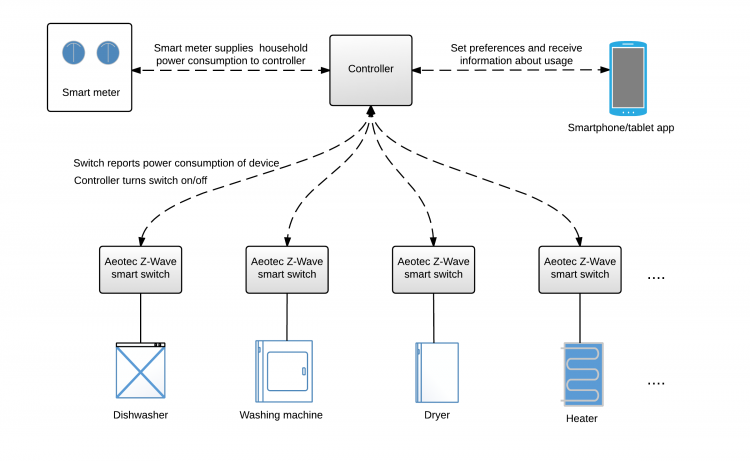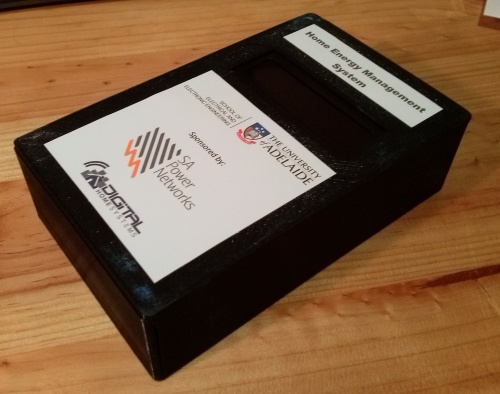Projects:2015s1-08 Developing a Home Energy Management System
Contents
Project Introduction
You’re used to being aware of how much energy you use. But have you ever thought about when you use it? Electricity utilities and researchers around the world have been tackling the problem of “peak demand”: the time during which the maximum power is drawn from the grid. It’s these “peak demand” events that put the most stress on the electricity network and determine how much network infrastructure needs to be built, which drives network costs.
South Australia has very “peaky” demand, primarily driven by the demand for air-conditioning during the state’s heatwaves. While household solar panels have reduced the energy SA customers draw from the power grid, they have not affected peak demand because peak demand tends to happen in the evening (when the sun is lower in the sky and the solar panels’ output has fallen as a result) as people come home from work. Peaky demand leads to inefficient use of the network and higher electricity prices. These reasons have led SA Power Networks – South Australia’s electricity distributor – to introduce a new, voluntary demand-based tariff. Instead of being charged only for how much energy they use, customers charges will split across a lower energy charge and a demand charge which is based on the maximum peak demand value.
Customers will be able to save money under this new tariff by changing the way they use electricity such that their peak demand is lower. Instead of using a large amount of electricity at one time, customers should spread their usage out over the day. However, many households find it difficult to make these changes and sustain them in the long-term. Often the time and effort needed to keep track of their demand and change their habits outweighs any potential savings. But this task can be made far simpler with the right technology. In a survey of 15 experiments with these kinds of tariffs, experiments with tariffs alone led to reductions in peak demand of 13-20%. However, when customers were provided with technology to help them adapt, far greater reductions in peak demand of 27-44% were possible [1].
This situation is the motivation behind the Home Energy Management System project initiated by SA Power Networks at the University of Adelaide. Cathryn McDonald and John Makestas, two Honours students in the School of Electrical and Electronic Engineering, have developed a system that takes the thought and effort out of reducing peak demand and saving money under a demand-based tariff.
Project Aims
A Home Energy Management System for existing devices - Our system consists of a central controller, wirelessly communicating with devices throughout a home. The system works with any mains-powered equipment users may already have in their homes, by using smart switches connected in line between the equipment and the power point.
Set a demand limit, and let the system do the thinking – Users set a demand limit that they wish to stay below, and the system intelligently controls the smart switches to prevent them from exceeding this demand. There is no need for users to keep track of what they are using; the controller takes care of that. If the user wishes to change their limit, they can easily do so via a smartphone app.
Set priorities for each device – Through the smartphone app, users can choose which devices are most important to them. In this way, the controller will make the best decisions for each individual user and operate as unobtrusively as possible.
Know where your energy is going – The system uses the smart switches to monitor the energy consumption of each device. It then provides feedback to users through the smartphone app. Users will be able to see the energy usage of each of their devices, and their usage profiles throughout the day.
Project Overview
The Home Energy Management System consists of the following hardware components:
Central Controller - The central controller monitors and controls devices throughout a home using wireless Z-Wave technology. It consists of a Raspberry Pi integrated with a Z-Wave daughter board and a Rainforest Raven USB module for Zigbee.
Smart Switches - Aeotec Z-Wave smart switches can be connected in-line between household appliances and their corresponding power point. These switches report demand data to the controller, and switch the appliances' power supply on and off as instructed by the controller.
Power Meter - A smart meter as used by SA Power Networks measures the total power consumed by the household and supplies this information to the controller. An Aeotec Z-Wave Home Energy Meter was also used for this purpose to provide additional reliability.
Relay Switches - Appliances compatible with the Australian Standard AS/NZS 4755 for demand-response-enabled devices are able to temporarily reduce their electricity demand as needed, without affecting their function. The relay switches control a demand-response-enabled airconditioner and energy storage unit, and the system can be expanded to additional appliances.
The Home Energy Management System also consists of the following software components:
Demand Management Algorithm - An algorithm has been developed to intelligently control smart switches and demand-response-enabled devices within a home, in order to keep total household demand within a pre-set limit. This algorithm works with the SA Power Networks demand tariff, avoids undue inconvenience to the user, and takes user preferences into account.
Controller Software - The controller software runs on the Raspberry Pi. It implements the above demand management algorithm as well as Z-Wave interfaces with other components. It receives demand data from the smart switches and power meter, and sends instructions to the smart switches and relay switches.
Smartphone Application - An Android application has been developed as a user interface. Users can interact with the system using their existing smartphones and tablets. The user interface allows customers to set their demand limit and priorities, and see information about power usage within their home.
Project Testing
A simulation study was undertaken to evaluate the effectiveness of the chosen algorithm in reducing peak demand. It identified that the algorithm was effective for households with many appliances including demand-response-enabled devices, but that its effectiveness could be improved by using a more advanced method to predict appliance load profiles. A more advanced method was identified, and this area has potential for future work.
A demonstration frame and load bank were built to test the system. The demonstration frame simulates the electrical wiring of a household, with eight power-points metered by a smart meter. The load bank uses lightbulbs to simulate appliance loads according to demand data from SA Power Networks.
The system successfully completed a series of tests to demonstrate correct functionality, including setting up the system, adding and removing appliances, and setting parameters. Initial demonstrations show that the system is able to keep the household demand below a limit.
A test procedure was devised to test the system's reliability, ability to reduce peak demand, and ability to operate with minimal inconvenience to the user. These tests are currently being undertaken.
Project Outcomes
The controller was implemented in hardware and software.
A demonstration board was constructed, consisting of a load bank with several smart switches attached.
A smartphone app was designed and developed for Android. This app allows users to see graphs of their total household demand and the demand of each appliance, add and remove appliances from the system, set a demand limit, and set appliance priorities.
MATLAB simulations show that the system is effective at reducing peak demand.
Future work in this area could include more extensive testing with larger sets of demand data, and with real appliances and household situations. The user interface could be improved through user testing and feedback, and the algorithm could be made more efficient by improving the method used to predict appliance load profiles.
Project Team
Group Members
Mr John Makestas - Hardware development, Z-Wave system development, project management
Ms Cathryn McDonald - Demand management software development, smartphone app design and development
Supervisors & Advisors
Dr Nesimi Ertugrul, The University of Adelaide - Project supervisor
Dr Hong Gunn Chew, The University of Adelaide - Project advisor
Stephen Webb, SA Power Networks - Industry advisor
Acknowledgements
SA Power Networks - Project initiation, sponsorship and advice
Digital Home Systems - Project sponsorship through the supply of home automation products
Electrical Engineering Workshop, The University of Adelaide - Construction of demonstration board and device case
Rachel McDonald - Smartphone app layout and graphic design


